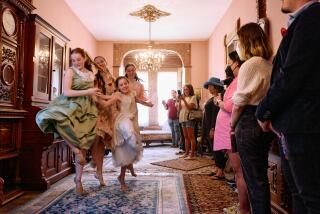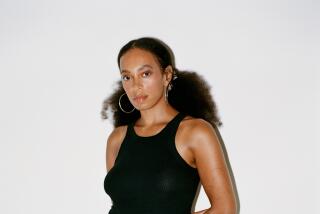DANCE REVIEW : A Decade of Dance With Livingston
- Share via
Highlighting creativity that actually spans more than a decade, the 10th anniversary program by Loretta Livingston and Dancers on Saturday at Japan America Theatre allowed a summary look at the modern dance choreographer’s interests and concerns.
It was at nearly three hours, however, an overly generous program that often distanced the strong dancers’ impact and energy from the audience by locating the action mostly mid-stage.
Livingston marked the alpha and omega of her career so far by juxtaposing “Balances,” a work made the year before she founded her own company in 1984, with a new piece, “Balances, Too.”
Originally produced at Cal Arts in Santa Clarita, “Balances” presented Livingston in modest, ingenious solo explorations of weight and volume and, yes, various balances, in stillness or motion, with ease or difficulty, with elegance or edgy risk. Livingston danced it with firm control.
In contrast, the new work, “Balances, Too,” a duet for Livingston and Madeline Soglin, looked sprawling, spun out from accumulated short-movement motifs and only loosely if at all connected with the accompanying text--prerecorded excerpts read by the choreographer from Pablo Neruda’s “The Book of Questions,” translated by William O’Daly.
Neruda wrote the work, according to the program, only months before his death. Therefore, one would like to give him (and the translator) a charitable latitude for such questionable profundities as “In the end, won’t death be an endless kitchen?” or “Tell me, is the rose naked or is that her only dress?”
Musings about the proper punishments of Hitler in hell only pointed up the airy, poetic illogic of so many of his other questions.
The dance began with the pose in which the earlier “Balances” ended: Livingston standing in a spotlight, precariously balanced on tip-toe, her arms extended overhead. Soglin tilted, maneuvered and even dressed her while she maintained the high tension of this iconic posture while lying on the floor. The tension quickly dissipated, however, as the two pursued parallel or separate movement interests that failed to accumulate weight and meaning.
Livingston, who danced for a decade in Bella Lewitzky’s company before striking out on her own, elsewhere presented work that ranged from intra-family drama to abstract movement study.
“Place Settings” (1984) used dream-like images and memory distortions to explore the linked influences among three generations of women (Soglin, Lynne DeMarco, and Stacia Voytek).
“Paper/Scissors/Rock” (1986) showed Livingston and David Plettner (her husband) expanding the familiar children’s game into playful, imaginative, challenging partnering relationships.
Dispersed over the program were three excerpts from “A History of Restlessness” (1992): “Drift,” an eloquent and fluid solo for Livingston; “Ice Age,” a pained and bitter power struggle between Michael Mizerany and DeMarco; and “Fault Zone,” an allusive study in surging wave movements for Mizerany, Plettner and Soglin.
The evening ended with “The Archives” from “A Window in the Passage” (1991), an impressive group piece about the collapse of idols. Here, as elsewhere, Doc Ballard was the sensitive lighting designer.
More to Read
The biggest entertainment stories
Get our big stories about Hollywood, film, television, music, arts, culture and more right in your inbox as soon as they publish.
You may occasionally receive promotional content from the Los Angeles Times.










